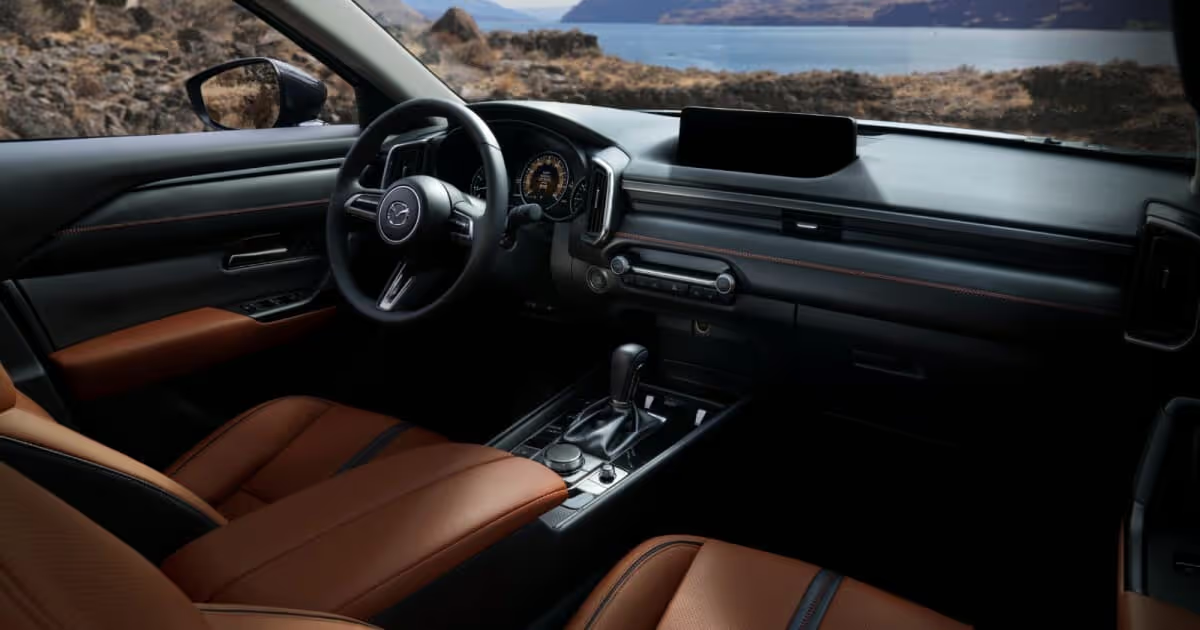Introduction to the Mazda CX-50
Mazda Cx 50 is not just another compact crossover in an already crowded segment—it’s Mazda’s bold statement about what it means to blend sophistication with rugged capability. Introduced to offer a more adventurous alternative to the brand’s existing CX-5, the CX-50 was designed with both the weekend explorer and the daily commuter in mind. It maintains Mazda’s signature driving dynamics while enhancing versatility, comfort, and off-road potential. Positioned between refinement and ruggedness, it symbolizes Mazda’s evolving design language and its ambitions to compete more aggressively in the SUV space.
Exterior Design and First Impressions
From the first glance, the Mazda CX-50 separates itself with its bolder, more muscular styling compared to other Mazda SUVs. It adopts a wider stance, a flatter roofline, and pronounced fender flares that hint at its capability beyond city streets. The long hood, angular grille, and sleek headlights reflect Mazda’s design philosophy of creating vehicles that look alive, even while standing still. This vehicle’s appearance speaks to a lifestyle—one where nature and pavement coexist, and where weekends involve road trips, mountain trails, or scenic detours.
Although the CX-50 shares a platform with the Mazda Cx 50, it is notably longer, wider, and lower, giving it a more planted and athletic look. Its proportions help reinforce its identity as an SUV designed for dynamic driving, rather than just utility. Thoughtful design touches such as black cladding, matte accents, and available roof rails enhance its adventurous appeal without sacrificing elegance. It’s a rare feat to make a crossover feel this purposeful in both urban and outdoor environments.
Interior Comfort and Design Philosophy
Stepping inside the Mazda CX-50, it’s clear that Mazda intended to create an interior that felt a class above the segment norm. The cabin exudes an understated luxury, with high-quality materials, clean lines, and minimalistic yet functional layout. The driver-focused cockpit wraps around you, reinforcing Mazda’s commitment to engaging driving experiences. Controls are intuitively placed, visibility is excellent, and there’s a harmony between the surfaces that speaks to Mazda’s Japanese design roots.
Depending on the trim level, the cabin features various premium touches—such as contrast stitching, padded door panels, and available leather upholstery—that elevate the experience. Seating is supportive and comfortable for long trips, with plenty of adjustments for finding the ideal driving position. Rear passengers benefit from generous legroom and headroom, especially compared to some rivals in the compact SUV segment.
Cargo space is functional, though not class-leading. The rear cargo area is well-shaped and includes clever tie-down points and compartments for added practicality. With the rear seats folded, it offers more than enough room for camping gear, groceries, or luggage, making it versatile enough for both adventure and everyday needs.
Performance and Driving Dynamics
Driving the Mazda CX-50 is where it truly sets itself apart. Mazda has always prioritized the driving experience, and the CX-50 carries that legacy proudly. Whether equipped with the standard naturally aspirated engine or the more powerful turbocharged variant, the CX-50 feels agile, composed, and more connected to the road than most other vehicles in its class.
The base engine is a 2.5-liter four-cylinder that delivers adequate power for daily driving. It’s smooth, quiet, and efficient, perfect for those who prioritize reliability and fuel economy. However, the turbocharged version is where the CX-50 shines for enthusiasts. With increased horsepower and torque, acceleration becomes lively, and the vehicle gains an extra layer of confidence during passing maneuvers and highway merging.
Mazda’s commitment to chassis balance and steering feel is evident here. The CX-50 offers crisp steering, responsive handling, and minimal body roll. The all-wheel-drive system, which is standard across all models, provides excellent grip in adverse conditions and improves off-road capability. While not designed for rock crawling, the CX-50 handles dirt trails, gravel roads, and mild terrain with ease, making it a true adventure-ready companion.
Ride Quality and Sound Insulation
The Mazda CX-50 achieves an excellent balance between comfort and sportiness. On smooth roads, the suspension absorbs imperfections gracefully, providing a refined ride without feeling disconnected. On rougher surfaces or light trails, the vehicle remains composed, with well-damped responses and minimal harshness. Mazda has also invested in improving noise insulation, and the results are noticeable. Road and wind noise are well-controlled, especially at highway speeds, allowing the cabin to remain quiet and serene.
The sense of stability at higher speeds and during cornering is another strong point. Unlike some crossovers that feel top-heavy or vague, the CX-50 remains poised and predictable, giving the driver confidence and a sense of control. This consistency in handling is one of the reasons Mazda vehicles continue to earn praise from driving enthusiasts.
Technology and Connectivity
Mazda has integrated a suite of modern technology into the CX-50, but in a way that aligns with its minimalist philosophy. The centerpiece is a widescreen infotainment display, which is not touchscreen-controlled in most trims. Instead, users interact with it through a rotary dial on the center console. While this approach may feel unfamiliar at first, many drivers grow to appreciate it for its simplicity and distraction-free operation.
Smartphone integration through Apple CarPlay and Android Auto is available, and in upper trims, it can be accessed wirelessly. There are multiple USB ports throughout the cabin, and features such as wireless charging, a head-up display, and a premium Bose audio system enhance the tech offering in more premium variants. Voice command functionality and navigation systems are available, though the infotainment interface could benefit from faster response times and a more intuitive menu structure.
Safety and Driver Assistance
Safety is a key focus for the CX-50. Mazda includes a comprehensive suite of advanced driver assistance systems across its lineup. These systems include adaptive cruise control, lane departure warning with lane keeping assist, blind-spot monitoring, rear cross-traffic alert, and automatic emergency braking. More advanced features, such as a 360-degree camera system and traffic sign recognition, are available in higher trims.
The vehicle’s structure has performed well in safety testing, and Mazda has continued to make improvements in crash protection, pedestrian safety, and vehicle stability. The inclusion of standard all-wheel drive further improves traction and control in poor weather conditions. The safety systems are designed to assist, not take over, and most operate subtly in the background, only intervening when needed.
Environmental Considerations and Hybrid Models
Mazda has gradually been expanding its electrification efforts, and the CX-50 reflects this strategy with the addition of a hybrid variant. This model is aimed at reducing emissions and improving fuel efficiency without sacrificing performance or usability. The hybrid version combines a gasoline engine with electric motors and a battery pack to deliver better fuel economy, particularly in urban driving conditions where stop-and-go traffic allows regenerative braking to shine.
This hybrid option retains much of the CX-50’s practicality and driving enjoyment, but adds a layer of efficiency that appeals to environmentally conscious drivers. Although not a plug-in hybrid, the system is capable of operating in electric-only mode at low speeds, contributing to quieter and cleaner operation.
Mazda’s Strategic Intent with the CX-50
The Mazda CX-50 is more than just a new nameplate—it represents the brand’s aspirations to expand its presence in the U.S. market and appeal to a broader audience. By introducing a model that caters to active lifestyles while preserving Mazda’s premium character, the company is aiming to capture drivers who might otherwise consider brands known for ruggedness, such as Subaru or Toyota.
Manufactured in the U.S., the CX-50 also reflects Mazda’s commitment to localized production and market-specific tuning. This means the vehicle’s ride quality, feature offerings, and packaging are all tailored to North American consumer preferences. As a result, it sits in a sweet spot between mainstream and luxury segments, offering value without feeling basic or utilitarian.
Ownership Experience and Reliability
Mazda has built a reputation for reliable vehicles that are enjoyable to drive, and early impressions of the CX-50 suggest that it upholds that tradition. Maintenance requirements are in line with industry norms, and the vehicle is backed by a standard warranty that covers basic and powertrain components for several years. The brand’s improving reputation for build quality and Mazda Cx 50 customer satisfaction further boosts the appeal of the CX-50 as a long-term ownership proposition.
Interior durability, software stability, and powertrain dependability are important considerations for buyers, and Mazda has worked to address these areas. The materials used in the cabin feel sturdy, buttons and knobs operate with precision, and the infotainment system, while occasionally slow, remains consistent in performance. As long as regular maintenance is observed, the CX-50 is likely to offer years of satisfying use.
The Verdict on the Mazda CX-50
The Mazda CX-50 is a thoughtful and well-rounded entry into the competitive compact SUV segment. It successfully merges Mazda’s core values—refined design, engaging driving dynamics, and elevated interior quality—with the practical needs of modern drivers. Whether used as a daily commuter, weekend getaway vehicle, or both, it delivers a sense of cohesion that makes it feel special.

